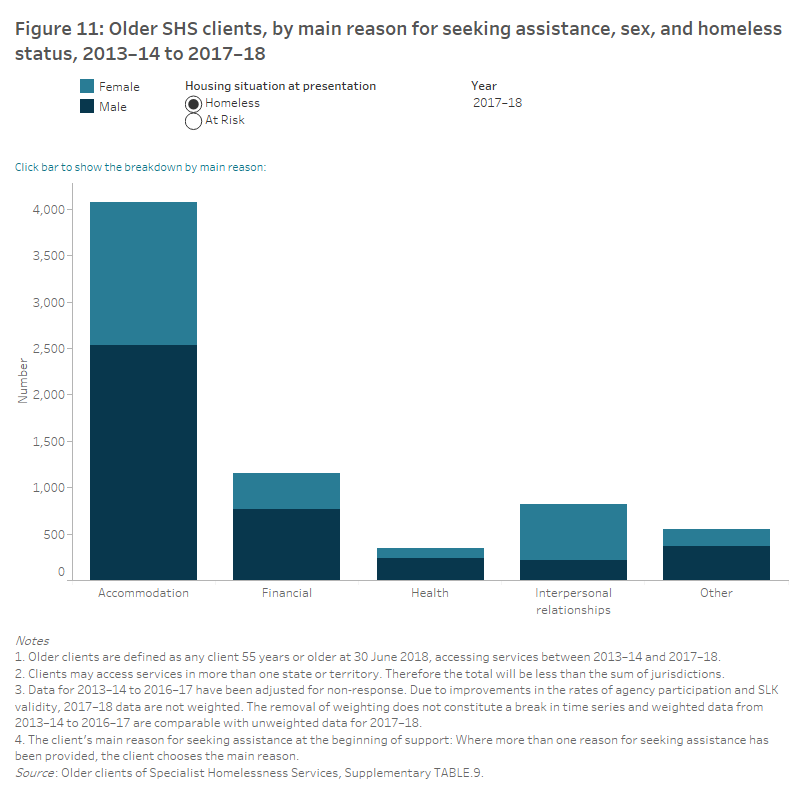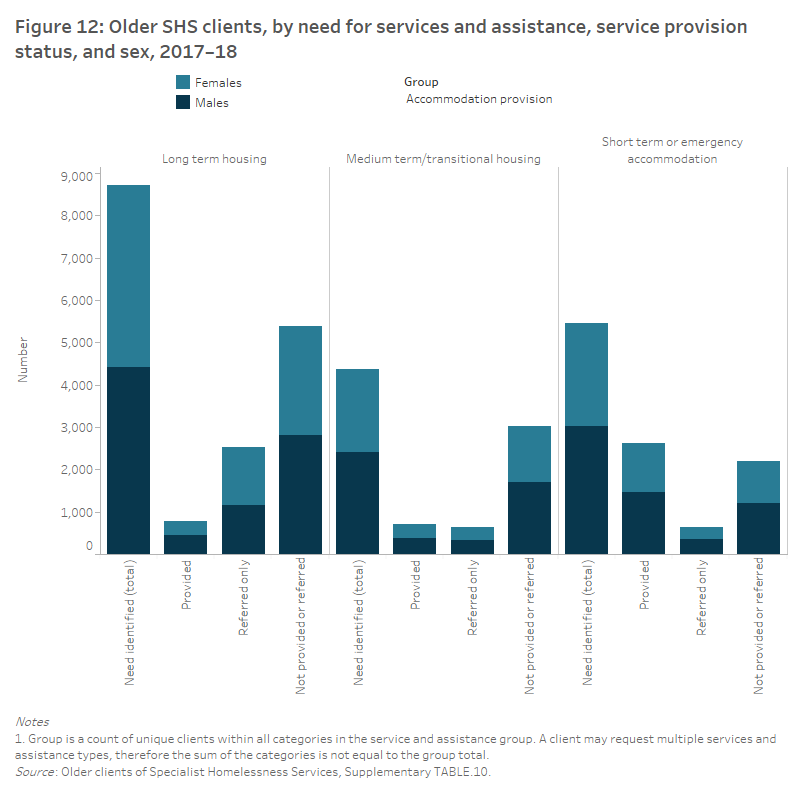Reasons and needs for SHS services
Main reasons for seeking assistance
There are many reasons older SHS clients may seek assistance from SHS agencies. In 2017–18, the main reasons older SHS clients sought assistance included:
- accommodation (59% of homeless and 32% of at risk clients),
- financial, including employment (17% of homeless and 31% of at risk clients),
- interpersonal relationships (12% of homeless and 21% of at risk clients),
- health (5% of both homeless and at risk clients) and
- other reasons (8% of homeless and 12% of at risk clients) (Figure 11).
In 2017–18, 8,400 clients sought assistance for accommodation; of these, 4,100 clients were experiencing homelessness at the start of support and 4,400 were at risk of homelessness.
The most common accommodation related main reason for older homeless SHS clients seeking assistance in 2017–18 was housing crisis (2,200 clients) followed by inadequate or inappropriate dwelling conditions (1,400).
Financial reasons were another common driver for seeking assistance in 2017–18, with 4,200 clients at risk of homelessness and 1,200 homeless clients noting it as a main reason for seeking SHS support. For those at risk, financial difficulties (2,800 clients) and housing affordability and stress (1,300) were the most common main financial reasons.
A considerable number of older female clients reported family and domestic violence as the main reason for seeking SHS assistance (2,500 clients) in 2017–18. It was the most common main reason for female clients at risk of homelessness seeking assistance (2,100 or 25% of females at risk of homelessness), but less so for female clients experiencing homelessness (400 or 15% of females experiencing homelessness).
Change over time
From 2013–14 to 2017–18:
- There was an increase in the proportion of homeless clients reporting housing crisis as the main reason for seeking assistance; up from 23% in 2013–14 to 31% in 2017–18.
- The number of male clients at risk of homelessness who sought assistance for financial difficulties increased from 1,100 clients to 1,300.
- The number of female clients at risk of homelessness reporting family and domestic violence as the main reason for seeking assistance has increased from 1,600 clients to 2,100 over the period.
- The proportion of homeless male clients seeking assistance for accommodation related reasons increased from 54% (1,600 clients) in 2013–14 to 61% (2,500 clients) in 2017–18 (Supplementary table 9).

Services needed and provided
Services available to clients are extensive and range from housing/accommodation (such as short term or emergency accommodation) and general assistance (such as financial information) to specialised services (such as health/medical services). Clients’ needs for services are collected from both the client’s and the agency worker’s perspective. In addition to the need for services, information is recorded about whether the service was provided or whether a referral was made. Clients may have multiple support periods and report multiple needs on each occasion, and receive multiple services during each support period.
In 2017–18, older SHS clients most commonly needed general services (22,600 clients or 94%). Of the general services:
- The most common service provided to clients was advice and information (17,400 clients); provided to 98% of those with this need.
- Advocacy and liaison services were also commonly needed (11,900 clients) as well as material aid and brokerage (7,400 clients).
- Almost 4,900 females (35% of female clients) identified a need for assistance for domestic/family violence and 76% (3,700 clients) were provided with this type of assistance (Figure 12).
Need for accommodation
In 2017–18, 11,100 older clients (or 46% of all clients) identified a need for accommodation provision. Of these clients needing accommodation, 3,900 (35%) were provided with this assistance (Supplementary table 10).
A higher proportion of males identified a need for accommodation (56% of all male clients) than females (39%). For both older males and females, long-term housing was the most needed service, but the service least often provided. A tenth (10%) of older male SHS clients and 8% of females with a need for long-term housing received it. More clients were referred to another agency for long-term housing (26% of males and 32% of females with this need). Around 38% of clients were either provided with or referred to another agency for long-term housing (36% of males and 40% of females).



